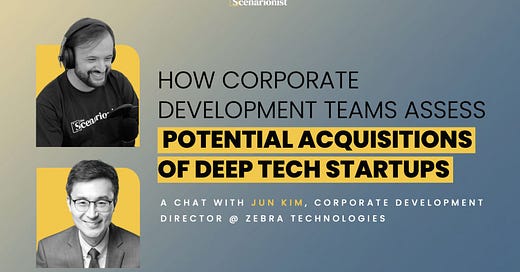✨ This is a Free Edition of The Scenarionist. To enjoy the full experience, become a Premium Member!
Welcome to the 65th edition of Deep Tech Catalyst, the channel by The Scenarionist, where science meets venture!
For many founders, M&A represents the ultimate milestone—the cornerstone exit strategy to envision from day one. It’s a chance to scale, unlock liquidity, and integrate into a larger corporate ecosystem. But what does it take to catch the attention of corporate acquirers? And how can startups position themselves for a strategic, high-value exit?
In this episode, we go behind the scenes of corporate development and M&A strategy, uncovering the key factors that drive acquisition decisions, with a focus on examples from warehouse robotics. With insights from Jun Kim, Corporate Development Director at Zebra Technologies, we explore:
How corporations assess potential acquisitions.
The critical financial and operational metrics that make startups attractive targets.
Common M&A pitfalls that can derail a deal—and how to avoid them.
Whether you’re a founder actively defining your exit strategy through an acquisition, a VC looking to position portfolio companies for acquisition, or an investment banker facilitating deals, this episode provides a valuable overview of how to approach corporate M&A successfully.
Let’s dive in! 🚀
✨ For more, see Membership | Partnership | Deep Tech Briefing | Insights
KEY INSIGHTS FROM THE EPISODE
🏭 What Drives a Corporation to Acquire a Startup?
While financial considerations play a role, strategic investors are mainly driven by business alignment. Their reasons for acquiring startups include:
Access to new technologies – Instead of building solutions from scratch, corporations may acquire startups with proven innovations.
Customer diversification – Acquiring a startup may help expand into new customer segments or geographies.
Faster go-to-market strategies – Instead of investing years in internal R&D, companies can accelerate their growth through acquisitions.
Buy vs. Build
Before acquiring a startup, corporations conduct a buy vs. build analysis. This assessment helps them determine whether it’s more efficient to develop a solution in-house or purchase an existing company.
Key considerations in this analysis include:
Time to market – Building a new capability in-house may take years, whereas an acquisition provides an immediate solution.
Cost efficiency – In some cases, acquiring a startup is more cost-effective than investing heavily in internal R&D.
Strategic fit – If a startup’s product or service aligns closely with the company’s long-term objectives, acquisition becomes a compelling option.
Ultimately, the decision to acquire a startup is not just about cost but about achieving strategic goals efficiently.
🔎 How Corporations Source and Identify Startups for Acquisition
Corporate M&A teams typically have a strong sense of where to look for potential investment opportunities because they are already operating within the same industry or adjacent markets.
Their primary sourcing methodology relies on internal business units, as these teams: have deep expertise in relevant technologies and industry trends and understand the competitive landscape, including potential partnerships and rival innovations.
External Sources
Despite their industry knowledge, M&A teams sometimes miss emerging startups that are not yet on their radar. In these cases, they turn to external sources, such as:
Investment banks – These firms often introduce startups seeking acquisitions.
Venture capital firms – VCs bring attention to high-potential startups in their portfolios.
Consulting firms – Industry consultants frequently highlight companies that could be strategic fits.
How Founders Can Get in Touch with M&A Teams
For startup founders interested in acquisition opportunities, proactively engaging with the right networks is key. Some best practices include:
Building relationships with corporate business units that align with your industry.
Engaging with investment bankers and VCs who can introduce your startup to corporate buyers.
Participating in industry events where strategic investors actively scout for new opportunities.
🎯 How M&A Teams Evaluate Strategic Fit in Hardware Acquisitions: The Case of Warehouse Robotics
When a corporation considers acquiring a startup, one of the most critical factors is strategic fit—how well the startup aligns with the company’s long-term vision and operational needs. But how do M&A teams evaluate this fit, especially for hardware companies in verticals like warehouse robotics?
Strategic Fit is a Company-Wide Decision
M&A strategies are not developed in isolation by corporate development teams. Instead, they must be closely aligned with the company’s overall strategy and the individual business unit strategies. For example, in warehouse robotics, a corporation must collaborate with internal experts who deeply understand the industry. These specialists provide insights into market trends, emerging technologies, and competitive dynamics.
The Case of Warehouse Robotics: A Fragmented Market
Warehouse robotics is a prime example of a highly fragmented industry, with numerous companies offering a wide range of solutions.
These solutions fall into different categories, such as:
AS/RS (Automated Storage and Retrieval Systems)
AMR (Autonomous Mobile Robots)
AGV (Automated Guided Vehicles)
Each of these solutions serves distinct purposes, and no single company currently dominates the entire landscape. This means that before making an acquisition, corporations must carefully analyze which solutions best complement their existing capabilities and long-term goals.
Key Indicators for M&A
For startup founders seeking acquisition opportunities, understanding how M&A teams assess strategic fit is crucial. Here are some key indicators to be aware of:
Technology Alignment – Does your startup’s solution complement or enhance the acquiring company’s existing technology stack?
Market Positioning – How does your startup differentiate itself within a fragmented market?
Scalability & Integration Potential – Can your product be seamlessly integrated into the acquirer’s operations?
Customer Overlap & Expansion – Does your startup provide access to new customer segments, or does it strengthen existing relationships?
Operational Synergy – Will your company’s solution streamline workflows or improve efficiency within the acquiring company’s ecosystem?
The Decision-Making Process
Before selecting an acquisition target, companies assess their own strengths and weaknesses to determine which solutions will provide the most strategic value. This involves in-depth discussions with internal stakeholders, evaluating where the company wants to expand its capabilities, and identifying gaps that a startup could help fill.
🚦 How Corporate Development Teams Operate: Structure and Decision-Making
Every company has its own structure, but in most cases, corporate development teams act as the execution arm for M&A and strategic investments. Unlike business unit leaders, corporate development professionals are not necessarily technical, business, or operational experts. Instead, their primary role is to:
Manage the M&A process – Ensuring deals progress efficiently and strategically.
Collaborate with business unit leaders – Working with internal experts who identify strategic acquisition needs.
Provide an objective perspective – Evaluate deals beyond technical excitement to ensure financial and operational feasibility.
How M&A Decisions Originate
M&A ideas typically come from business unit leaders who recognize gaps in their market strategy. For example, within a company specializing in warehouse robotics, internal teams may identify a missing capability that would accelerate their strategic roadmap.
A business unit may determine that acquiring a specialized company is the best way to fill a market gap.
They then bring in the corporate development team to help evaluate the acquisition from a process and feasibility standpoint.
Conversely, the corporate development team may identify a promising opportunity and introduce it to the business unit for consideration.
This two-way collaboration ensures that acquisitions align with both the technical vision of business units and the financial and strategic reality assessed by the corporate development team.
Balancing Technical Enthusiasm with Business Viability
One of the biggest challenges in corporate M&A is balancing the excitement of technologists with the economic realities of an acquisition.
Internal teams may get excited about cutting-edge technology and push for an acquisition.
However, corporate development takes a step back to evaluate whether the deal makes sense financially and operationally.
This objective approach prevents emotion-driven decisions and ensures that investments align with long-term goals.
💰 How Have Financial Priorities Shifted?
When discussing mergers and acquisitions in the industrial hardware sector, it's essential to understand how financial considerations differ from the SaaS economy. While technology and innovation remain crucial, corporate investors today are placing increasing emphasis on financial sustainability.
The Shift from Technology to Financial Viability: Implications for Founders and VCs
Corporate investors are becoming more selective in their acquisitions. While technology maturity was once the primary focus of industrial M&A, the landscape has changed. Many now prefer to wait until startups prove financial sustainability before making a purchase—even if it means paying a premium later.
The era of acquiring companies just for their innovation is fading—corporations expect startups to figure out profitability on their own first.
In detail, even if a startup shows strong growth potential, corporate acquirers now prioritize:
Profitability or a clear, short-term path to it (typically within 1-2 years). Startups that lack a clear path to profitability are no longer attractive targets.
Corporate acquirers value operational efficiency and strong financial metrics, not just promising technology
A sustainable business model capable of operating independently, without ongoing investor support.
Is There a Specific Revenue or Profitability Threshold?
There is no strict financial threshold that determines whether a company qualifies for acquisition. However, M&A teams typically assess companies based on:
Revenue size – Companies generating less than $10 million in revenue and still unprofitable may not be immediate M&A targets.
Profitability – While not always required, having a clear pathway to profitability strengthens a startup’s acquisition potential.
Sector-specific benchmarks – Expectations vary depending on whether the business operates in SaaS, hardware, or other industries.
Examples of Profitability Expectations by Sector
Different industries have different profitability benchmarks when being considered for M&A:
SaaS Companies – Expected to achieve at least 30% EBITDA margins at scale.
Hardware Businesses – Typically have lower margin expectations, given the capital-intensive nature of the industry.
While there’s no one-size-fits-all metric, startups should understand the financial expectations within their sector and position themselves accordingly when engaging with corporate M&A teams.
And what about early-stage, pre-revenue, or unprofitable startups?
M&A teams often rely on venture capital (VC) investments first rather than pursuing an immediate acquisition.
If a startup has high potential but lacks profitability, corporate investors may invest through their venture arm to help the company scale.
This approach allows them to gain an early stake while minimizing acquisition risk.
If the startup successfully scales and proves its financial viability, it becomes a stronger M&A candidate in the future.
🤝 The M&A Process: A High-Level Overview for Founders
Mergers and acquisitions (M&A) involve a structured and often complex journey that founders and investors must navigate. Understanding the key steps can help startups prepare for the process and approach it with the right expectations.
1. The First Step: Signing an NDA
The M&A process officially begins with a Non-Disclosure Agreement (NDA). This document ensures that both parties keep all discussions and shared information confidential throughout the transaction.
The NDA serves as a formal starting point for the deal.
At this stage, the seller (the startup) shares limited information with the potential acquirer—just enough for them to evaluate initial interest.
2. The Letter of Intent (LOI): Initial Offer & Terms
Once preliminary discussions confirm mutual interest, the buyer issues a Letter of Intent (LOI).
The LOI is a non-binding offer, meaning either party can walk away based on due diligence findings.
It provides a more precise valuation range and outlines the key deal terms.
This step allows both parties to deepen their understanding of each other before committing to the deal.
3. Due Diligence & Negotiation
After signing the LOI, the M&A process moves into extensive due diligence—arguably the most intensive phase of the deal.
The buyer conducts a thorough financial, legal, and operational analysis of the startup.
Negotiations take place to finalize key terms and validate assumptions made in the LOI.
This stage determines whether the deal will move forward or be reconsidered.
4. Signing the Purchase Agreement
Once due diligence is complete and both parties agree on the terms, they move to signing the final agreement.
5. The Period Between Signing and Closing
Signing the agreement does not mean the deal has officially closed. There is often a gap between these two events, allowing both parties to:
Validate final conditions – Ensuring everything agreed upon in the contract holds true.
Begin integration planning – Preparing for a smooth transition post-acquisition.
Meet any remaining regulatory or financial obligations.
6. Closing the Deal: The Final Step
The deal officially closes when the final exchange of ownership takes place.
3 Red Flags to Avoid Before Approaching an M&A Discussion
Many startups prioritize rapid growth, optimizing for speed over structure. However, if a sale is on the horizon, it’s crucial to start organizing early—even if it temporarily slows things down. Additionally, working with investment bankers or consultants can bring much-needed structure to the process. Here are three common red flags to avoid before approaching an M&A discussion.
1. Standardization vs. Customization
Many SaaS and software startups build highly customized solutions for individual clients to grow revenue quickly. While this may work in the short term, it can create operational chaos later. Buyers prefer startups with scalable, standardized products rather than custom-built solutions that require heavy engineering effort. If a company resembles a custom software development shop more than a SaaS business, it may struggle to attract buyers.
2. Cybersecurity & Compliance
Many startups overlook cybersecurity and internal controls, assuming they can fix these issues later. But for corporate acquirers, these gaps are major red flags. Security practices matter. Buyers don’t want to see sensitive business operations managed through unsecured platforms. Companies should implement authentication protocols, oversight systems, and proper security measures before approaching an M&A discussion.
3. Operations
A great analogy for M&A preparation is “organizing your house before inviting guests over.” Buyers will examine everything—from financial records to operational processes. If a company has disorganized finances, compliance issues, or inefficiencies, the buyer will notice and may reconsider the deal. A startup with strong internal organization is far more attractive than one with rapid growth but a poor structure.
✨ Join The Scenarionist Premium today!
Unlock access to our exclusive Venture Guides, and much more—available only to our premium members. This includes our carefully curated list of 30 Venture Lessons to Build and Back Great Deep Tech Companies, distilled from the insights of 50+ Deep Tech investors and experts from around the world.













